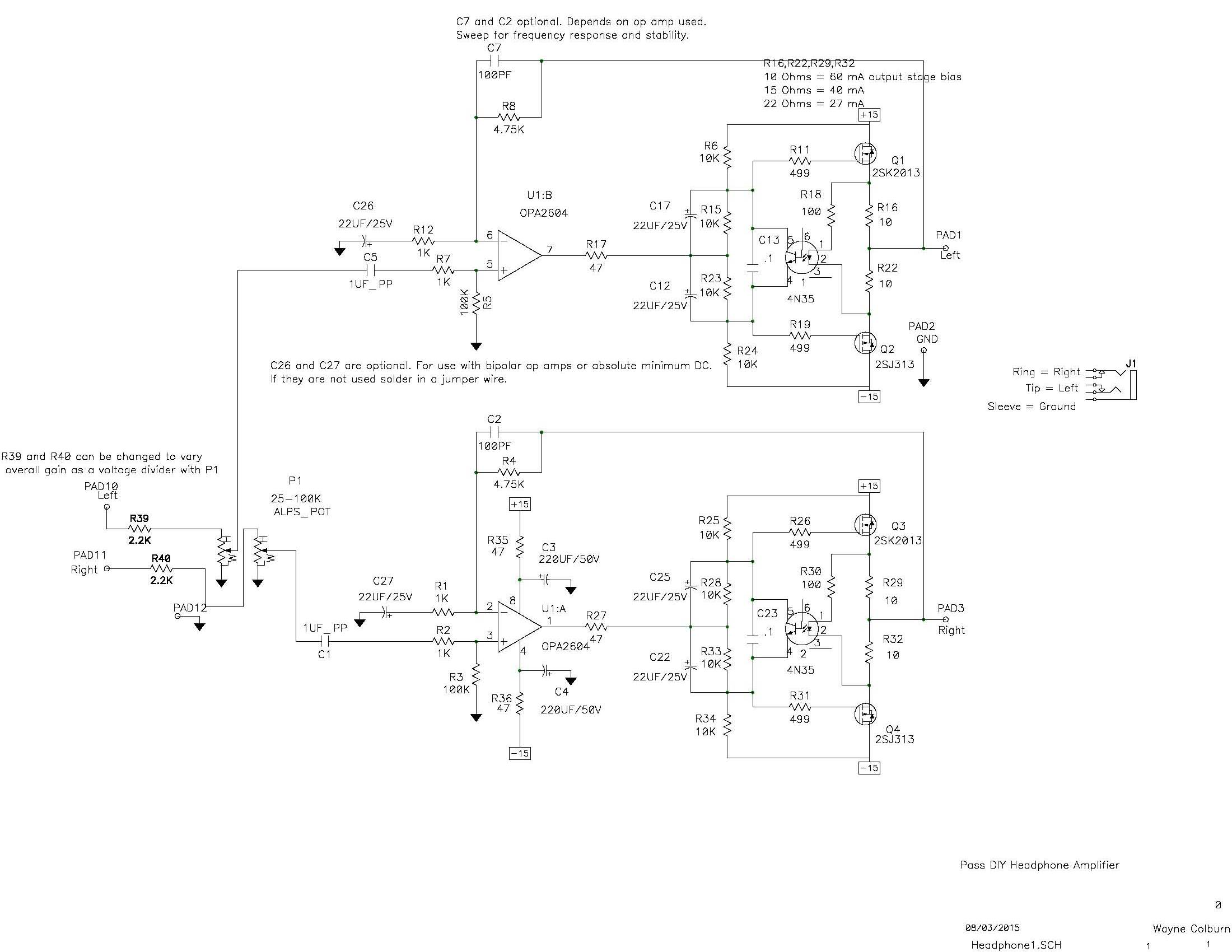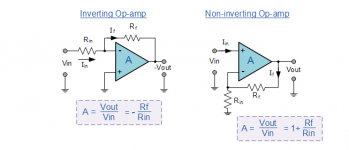Ah James, you need to reduce the gain for the Ety's, eh
Well, first I'd just increase that R12 from unit gain setting of 10kR to maybe around 15kR to see if that reduces your gain to around the 0.6 for the Ety's.
You could then just add a switched extra resistor in parallel to this new increased value resistor to get a value somewhat below the original unity gain value of 10kR - for a gain of 3, that is. You could also add a parallel pot for adjustable gain too but …
There's sure to be associated problems with switching/changing gain setting too, especially if done with amp turned on - perhaps add a muting cct to be safe.
Well, first I'd just increase that R12 from unit gain setting of 10kR to maybe around 15kR to see if that reduces your gain to around the 0.6 for the Ety's.
You could then just add a switched extra resistor in parallel to this new increased value resistor to get a value somewhat below the original unity gain value of 10kR - for a gain of 3, that is. You could also add a parallel pot for adjustable gain too but …
There's sure to be associated problems with switching/changing gain setting too, especially if done with amp turned on - perhaps add a muting cct to be safe.
As Papa always says: Safety first. So yes, you want that capacitor. It's 0.47uF 250V ceramic or film, Mouser 667-ECQ-E2474JFB e.g.
In the last one I built, I used the 'house ground kit' that's mentioned somewhere else on this site. Let me see if I can find it. It provides a somewhat better connection and is similar to what Pass Labs uses, or so Wayne said.
Thanks so much! Ive got to say this built is not the easiest for newbie like me, since theres a lot of assumed knowledge and parts in the guide. But im really looking fwd to hearing the final product!
i'll get the capacitor u suggested instead of the Hse ground Kit as i live abroad and shipping cost 40 usd alone...
Last edited:
For Mr dbCooper, about setting the gain
I was curious about this and went back to the first post here and under the heading called CIRCUIT, the 3rd line says
Gain is set by R8/R12. Lower gain, make R12 bigger, unity gain, R12=10K
The standard circuit diagram shown has R8 = 4k7r and the R12 = 1kR so this gives gain of 4.7 - do you need any more?
The formula is R8/R12 (On both channels)? If so, all I need is that and a switch recommendation and a little wiring diagram. Like I said in my original post, I have little in the way of DIY skills and can't seem to make much sense of a schematic but can follow pictorial diagrams, as I have building the Dynaco, Hafler and Van Alstine kits, all of which worked from power-on. Thanks for directing me to the math which I jumped past.
Ideally I'd like something like the Noir/T2 kit, with enclosre,which would require only addition of one simple round hole to add a toggle or pushbutton switch, but it seems not to be in the cards anytime soon..
I wish the board design had supported this common function, which could be jumpered out for people who didn't want or need it.
Last edited:
Gain is set by R8 and R12. The numerical value of gain is, however, not equal to the ratio "R8/R12".
Sooo...what values would I need to get, say, 1x and 3x? Repeating myself, I have no EE experience... just enough direction-following ability to follow directions ("make R12 xxxx ohms for a gain of Xx") and such.
Sooo...what values would I need to get, say, 1x...
For unity gain, remove R1 & R12, fit links in place of R4 & R8; C2 & C7 and C26 & C27 are redundant and can be removed.
I haven't tried it, be careful, some opamps aren't unity gain stable.
Last edited:
Unfortunately it is simply too much work, for me to go search the thread history and find the earlier posts where this analysis was performed; sorry. Maybe somebody else is more motivated than me.
Well, since I was the one looking for a solution, I was motivated enough to have gone through about half of the thread's 300+ pages without finding the answer. I didn't spot it in the first half of those 300 pages ("Lower gain, make R12 bigger" seems a little too vague for my knowledge level.) It looks like the complication created just by adding the gain switch takes it past the 'kit' style project I was looking for. There even seems to be some disagreement as to the gain ratio math. I lack the training to know who's right.
So I think I'm letting it go and maybe looking for another project at some point in the future. Too bad, because I could absolutely build this board. My Van Alstine Super PAS 4i hybrid preamp kit was at least as complex a build, but it was 'turnkey' from an EE and mechanical design standpoint, so it was more to my skill level. Thanks to those who offered help.
For unity gain, remove R1 & R12, fit links in place of R4 & R8; C2 & C7 and C26 & C27 are redundant and can be removed.
I haven't tried it, be careful, some opamps aren't unity gain stable.
Another design issue I don't have the knowledge to evaluate. At any rate it seems like adding a switchable gain arrangement adds more complexity than I realized. Too bad, because I know from experience with the two very electrically different headphones I am using now that switchable gain makes this a lot easier to do. As I indicated in my previous post, I'm starting to think that unless something changes significantly in my headphone line up, this isn't the project for me due to the lack of an easy way to do gain switching. A 'one trick pony' that only works with my 250Ω Beyers doesn't do it for me; I'm looking for one amp that does it all, not a desk covered with boxes. Right now it seems like the O2 I've got now might actually fit that need better. But thanks for the reply.
Remind me again, what it the impedance of your other headphone? I am not very versed in electronics, but I have to ask if you can't just place a resistor on the cable of the headphone with the lower impedance and match the Beyers? it doesn't really make any difference if you change the gain with a resistor internally or externally does it?
I’ve used whammy with IEM, 25 ohm Denon , 250 beyers, 300ohm sennheiser, and more, as well as a number of IEM’s.
I also have an O2.
The O2 is very, very good sounding, and yes, the gain switch is useful.
The Whammy cleanly and completely blows the O2 out of the water in sound quality and I’ve never had an issue with adjusting volume vs. headphone sensitivity.
Long story short, I think you’d really like it.
I also have an O2.
The O2 is very, very good sounding, and yes, the gain switch is useful.
The Whammy cleanly and completely blows the O2 out of the water in sound quality and I’ve never had an issue with adjusting volume vs. headphone sensitivity.
Long story short, I think you’d really like it.
dB_Cooper - I’m late to the conversation, what is the reason for your requirement to have switchable gain?
Also, have you tried the circuit as-is and determined through experience that the stock gain is not suitable for your needs?
I am basing it on my experience with my O2 and the volume control range I have available with the two headphones and associated equipment I have. I have a 2 volt RMS DAC. Headphones are 45Ω Etymotics (very sensitive) and 250Ω Beyers (a much 'stiffer' load). At the Low gain setting (0.67) my Etys work pretty well, usually at a VC setting about halfway gove or tak, depending on source material, At that gain setting, the volume has to be just about pegged to get anything out of the Beyers.
Conversely at the hi-gain setting (3.4x in my O2) I barely have any volume control range with the Ety's (usable range about 9 o'clock max) but that setting works pretty well with the Beyers. In fact, it could be a bit lower, closer to 3x, as the usual range is between 9 and 11 o'clock. agdr did the mods for me and also installed gain resistor socket so adjusting the high gain position down a little bit wouldn't even involve soldering. He even supplied me the math to do it. Unfortunately, he seems to have disappeared into the Bermuda triangle much as NWAVGuy did.
These two headphones have very different electrical characteristics and sensitivities, and my experience with the O2 is what leads me to believe that it would be hard to find a happy middle ground with a single gain ratio amp. I have not tried the test you describe because it would cost me ~$200 to do it. Right now that's a bigger bet than I want to make for reasons that I can't go into on the board due to a family situation that is flaring up. And, as I've indicated in my other post, I really don't feel like I have the knowledge to re-engineer the device to accommodate the requirement. Maybe the time just isn't right. Thanks for the reply however.
The volume pot has at least 50 dB of adjustability. Adjusting gain can affect sound quality, noise, distortion and stability. Build it first and try it.
Hmm, maybe if there are people here that have had experience using this amp with IEMs- and if its quiet with them- that's obviously the main question but it's hard to believe that making the leap from 0.67 to 4.7 gain factor would work when 3.4 is already too much. Maybe what I need is another box on my desk though....
My o2 has the 'booster board' mod (subject of a thread here) by agdr btw, which replaces essentially the entire output stage, so hardly a bone-stock O2, Why does everybody involved with the O2 seem to get abducted by aliens or something? It's one of the biggest mysteries in audio
If I do build it I'm doing it 'bone stock', no amateur 'upgrades' of any kind (boutique parts etc).
Thanks for your attention 6L6 and Wayne.
Last edited:
- Home
- Amplifiers
- Pass Labs
- "WHAMMY" Pass DIY headphone amp guide

